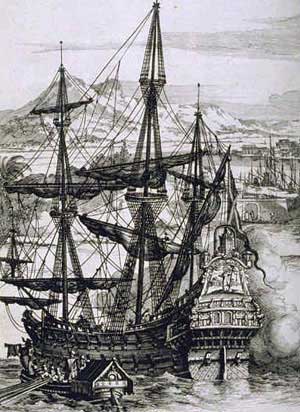 |
This is a file from the Wikimedia Commons. Information from its description page there is shown below.
Commons is a freely licensed media file repository. You can help.
|
A Spanish Galleon. Public domain by age.
| Public domainPublic domainfalsefalse |
 |
This image (or other media file) is in the public domain because its copyright has expired.
This applies to Australia, the European Union and those countries with a copyright term of life of the author plus 70 years.
 You must also include a United States public domain tag to indicate why this work is in the public domain in the United States. Note that a few countries have copyright terms longer than 70 years: Mexico has 100 years, Colombia has 80 years, and Guatemala and Samoa have 75 years, Russia has 74 years for some authors. This image may not be in the public domain in these countries, which moreover do not implement the rule of the shorter term. Côte d'Ivoire has a general copyright term of 99 years and Honduras has 75 years, but they do implement the rule of the shorter term. You must also include a United States public domain tag to indicate why this work is in the public domain in the United States. Note that a few countries have copyright terms longer than 70 years: Mexico has 100 years, Colombia has 80 years, and Guatemala and Samoa have 75 years, Russia has 74 years for some authors. This image may not be in the public domain in these countries, which moreover do not implement the rule of the shorter term. Côte d'Ivoire has a general copyright term of 99 years and Honduras has 75 years, but they do implement the rule of the shorter term.
|
|
This file has been identified as being free of known restrictions under copyright law, including all related and neighboring rights.
|
From w:Image:Spanish_Galleon.jpg :
- I found the galleon picture from a website that didn't cite the image, although I've also seen it in two books (History of the World: The last five hundred years (1986) by Bonanza Press and Naval Warfare: 1492-1792, Cambridge University Press (1999)) The first one lists it as a "Sixteenth-century engraving of a Spanish galleon by Albrecht Dürer," while the second lists it as an "Anonymous sixteenth century engraving of a Spanish galleon." I'm kind of skeptical that Dürer did it, but I couldn't find any citations online for it. Sorry. Adam Faanes 15:12, 21 Aug 2004 (UTC)
- Yes, it may not be from Dürer because he died 1528 and the ship shows a sprit topmast, which was addet in the early 17the century (1620). -- 80.136.67.90 16:22, 13 August 2008 (UTC)
-
-
- It's almost certainly a mid-17th century ship, not a 16th-century one. They looked entirely different. Fut.Perf. ☼ 18:19, 27 March 2011 (UTC)
Uploaded there by Adam Faanes.
File usage
The following pages on Schools Wikipedia link to this image (list may be incomplete):



